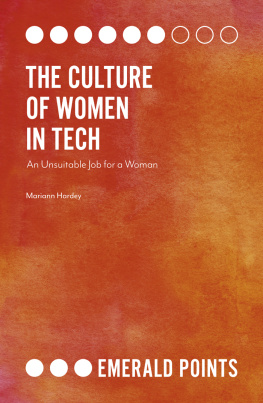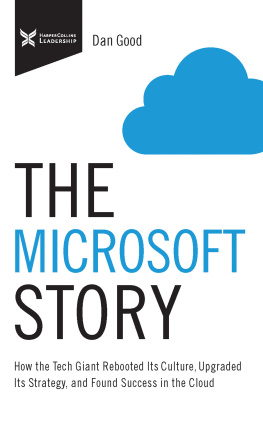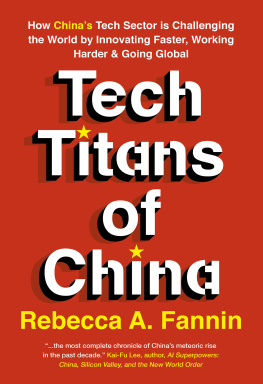Dedicated to my daughter Darcey, and to Henry
Praise for The Culture of Women in Tech
The contemporary, liberal aesthetic of the digital technology sector is categorically undermined by this insightful text, which draws on women's voices to evidence the toxic conditions of their working lives and how gender inequalities remain shaped and reinforced by space and place.
Professor Andy Miah, Chair in Science Communication & Future Media, University of Salford
The lack of women working in the tech sector is a well-documented problem. Even more worrying to me is the lack of women considering a career in technology. I welcome Mariann's contribution to understanding the issues around a lack of diversity in tech especially looking across a number of leading cities around the world to provide a meta look across multiple clusters.
Herb Kim, Director, The Thinking Digital Conference
Having set up the UK's first online Women in Tech network BCSWomen over 20 years ago in response to my negative experiences at tech conferences I've been active in this area for a generation. This book adds so much to our understanding of what is really going on in tech culture around gender and diversity and as such is completely invaluable. A seminal, pioneering work that makes a fundamental contribution, read it now.
Sue Black OBE, Professor of Computer Science, Durham University
Contents
Emerald Publishing Limited
Howard House, Wagon Lane, Bingley BD16 1WA, UK
First edition 2020
2020 Mariann Hardey
Published under exclusive licence by Emerald Publishing Limited.
Reprints and permissions service
Contact:
No part of this book may be reproduced, stored in a retrieval system, transmitted in any form or by any means electronic, mechanical, photocopying, recording or otherwise without either the prior written permission of the publisher or a licence permitting restricted copying issued in the UK by The Copyright Licensing Agency and in the USA by The Copyright Clearance Center. Any opinions expressed in the chapters are those of the authors. Whilst Emerald makes every effort to ensure the quality and accuracy of its content, Emerald makes no representation implied or otherwise, as to the chapters' suitability and application and disclaims any warranties, express or implied, to their use.
British Library Cataloguing in Publication Data
A catalogue record for this book is available from the British Library
ISBN: 978-1-78973-426-3 (Print)
ISBN: 978-1-78973-423-2 (Online)
ISBN: 978-1-78973-425-6 (Epub)
List of Figures
| Figure I.1 | Project Timeline. | 13 |
| Figure 2.1 | Attitudes and Behaviours Formed Around the Use of the WiT Label in Association with Women, Grouped by Higher- or Lower-ranked Professional Groups. | 52 |
| Figure 2.2 | Showing the Representation of Attitudes and Behaviours Formed Around the Use of the MiT Label in Association with Men, Grouped by Higher- or Lower-ranked Professional Groups. | 54 |
| Figure 4.1 | Focus Group Analysis of Successful Candidate Type from Recruitment Advertisements. | 103 |
| Figure 4.2 | Bar Graph and Data Table Showing Number of Survey Respondents Who Directly Reported to a Female Manager. | 119 |
| Figure 4.3 | Bar Graph and Data Table Showing Number of Survey Respondents Who Had Received Formal Career Planning and Support in Their Current Position. | 120 |
| Figure 4.4 | Bar Graph and Data Table Showing Number of Survey Respondents Who Were Aware of Company Policy for Diversity in Recruitment. | 121 |
| Figure 4.5 | Bar Graph and Data Table Showing Number of Survey Respondents Who Had Received Consistent Performance Evaluations in Their Current Position. | 122 |
List of Tables
| Table I.1 | Summary of Tech Cluster Sites. | 7 |
| Table I.2 | Participant Characteristics. | 15 |
| Table 3.1 | Cultural-spatial Elements of Tech Clusters. | 96 |
Preface
A preface is, I am reliably informed, a space in which to anchor lineage, atone for potential wrongs and show appreciation for the many others who have supported this book.
This is a book primarily about the women in tech that seeks to address questions about diversity and equality of opportunity in tech companies, organisations and industry that impact any worker in tech.
This book is about attempts to redress the balance where women have found themselves trying to escape from stereotypes about competencies and appropriate roles along with attempts to progress a sense of their professional identity. Both women's and men's experience occupy these pages, though in very different ways, each continually shaping and feeding back into the other new opportunities and meanings within tech. Some workers take a dramatic turn away from a mainstream misogynistic blueprint, and the real heroes of these pages are a far cry from the popular media image of well-known women in tech the Sheryl Sandbergs, Arianna Huffingtons and Martha Lane Foxes. They are instead the many women and men who want to work and stay in tech as an industry that flattens, rather than makes mountains out of, inequality and to support diversity.
To commence, the lineage. The research for this book started life some 15 years ago, out of an opportunity to work with the Girl Geek Network, founded by Sarah Blow in London. At that time Sarah and many other women working in the tech sector were perturbed by the repetition of high-profile male speakers at tech networking and capital raising events. My attention to inequalities and to the significant shift to online profiles (this was 2004/2005) combined with a concern about the image of tech and how far women were from being known in professional tech spaces. As a sociologist of interaction, I was struck by the different spaces and expectations of workers' achievements that were both implicit and also made explicit by gendered terms and visual symbols.
During my Masters and Doctorate theses I had studied and written extensively about the new opportunities for interaction empowered by technology in ways that allowed individuals to set themselves apart from others and embrace difference. It was a very mundane behaviour that interested me then: creating an online profile, communicating with family and friends, reaching out and introducing oneself to new people, sustaining and maintaining friendships, and the distancing and estrangement of others. Though mundane, the emergent of new forms of online and digital etiquette I believed to be reflecting significant changes to everyday life and our relationship to others.
My determined pursuit of what, in retrospect, was a very optimistic view of the positive effect of such aspects of digital lives was reinforced by the specialist communities and groups that emerged onto social media. At this stage, I was interested in the rebalance of interactions away from previous modes of gendered behaviour. I wanted the new meaning behind digital interactions, the way in which individuals felt and regarded them, the way in which women and men related their experiences online to other elements of their lives. Today, this emphasis has been well documented. But over a decade ago when I first began to talk about new forms of etiquette and gendered meanings, I found myself on a crest of a new wave concerning the potential of tech to shake up and remove previous bias and prejudices.










